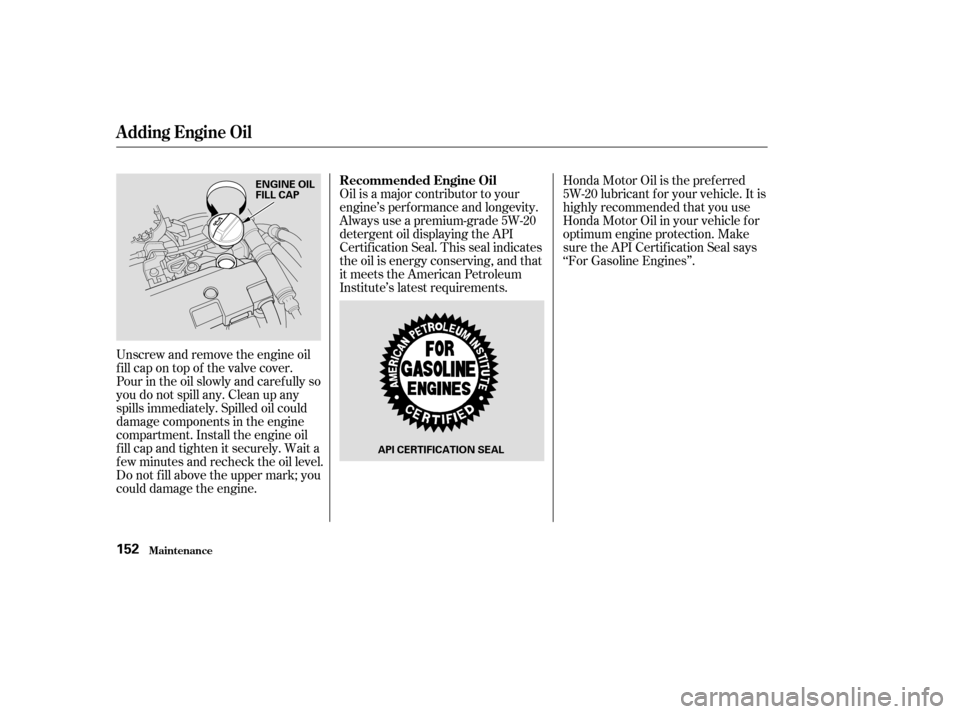Page 116 of 231
Lif t it up slightly to remove the
support rod f rom the hole. Put the
support rod back into its holding
clip. Lower the hood to about a
f oot (30 cm) above the f ender,
then let it drop. Make sure it is
securely latched.Remove the dipstick again and
check the level. It should be
between the upper and lower
marks.
Wait a f ew minutes af ter turning the
engine of f bef ore you check the oil.
Remove the dipstick.
Wipe the dipstick with a clean
cloth or paper towel.
Insert it all the way back in its tube. If it is near or below the lower mark,
see on page .
3.
1. 2. 4.
152
To Close the Hood:
Service Station Procedure
Bef ore Driving
Oil Check
A dding Engine Oil
117
SUPPORT RODGRIP
CLIP DIPSTIC UPPER MARK
LOWER MARK
�����—�����—�����y�
���������
���y���
�(���%�������y���
�����y
Page 122 of 231

�·�µ
The maximum load f or your vehicle
is 850 lbs (395 kg). This f igure
includes total weight of all occupants,
cargo, and accessories.
To determine the correct cargo and
luggage load limit:
Locate the statement, ‘‘the
combined weight of occupants and
cargo should never exceed 850 lbs
(395 kg)’’ on your vehicle’s placard
(on the driver’s doorjamb).
Determine the combined weight
of the driver and passengers that
will be riding in the vehicle.
Subtract the combined weight of
the driver and passengers f rom
850 lbs (395 kg). For example, if there will be f our 150
lbs (70 kg) occupants in your vehicle,
the amount of available cargo and
luggage load capacity is 250 lbs (115
kg).
4 150 lbs (70 kg) = 600 lbs (280
kg)
850 lbs (395 kg) 600 lbs (280 kg) =
250 lbs (115 kg)
Determine the combined weight
of accessories, luggage, and cargo
beingloadedinthevehicle.The
weight may not saf ely exceed the
available cargo and luggage load
capacity calculated in step 4.
The resulting f igure equals the
available load capacity. Store or secure all items that could
be thrown around and hurt
someone during a crash.
Do not put any items on top of the
rear shelf . They can block your
view and be thrown around the
vehicle during a crash.
Be sure items placed on the f loor
behind the f ront seats cannot roll
under the seats and interf ere with
the pedals or seat operation.
Keep the glove box closed while
driving. If it is open, a passenger
could injure their knees during a
crash or sudden stop.
1. 2. 3.4. 5.
Bef ore Driving
Carrying Cargo
Carrying Items in the Passenger
Compartment
123
�����—�����—�����y�
���������
���y���
�(���%�������y���
�����y
Page 125 of 231
Fasten your seat belt. Check that
your passengers have f astened
their seat belts (see page ).
When you start the engine, check
the gauges and indicator lights in
the instrument panel (see page).
Make sure the doors are securely
closed and locked.
Check the steering wheel
adjustment (see page ).
Check the adjustment of the
inside and outside mirrors (see
page ).
Check that any items you may be
carrying are stored properly or
f astened down securely.
Check the seat adjustment (see
page ).
Youshoulddothefollowingchecks
and adjustments every day bef ore
you drive your vehicle.
Make sure all windows, mirrors,
and outside lights are clean and
unobstructed. Remove f rost, snow,
or ice.
Check that the hood and trunk are
f ully closed.
Visually check the tires. If a tire
looks low, use a gauge to check its
pressure.
1. 2. 3. 4.
9.
8.
7.
6.
5.
10.
76
83 68 14
53
Driving
Preparing to Drive
126
�����—�����—�����y�
�������������y���
�(���%�������y���
�����y
Page 151 of 231

Oil is a major contributor to your
engine’s perf ormance and longevity.
Always use a premium-grade 5W-20
detergent oil displaying the API
Certif ication Seal. This seal indicates
the oil is energy conserving, and that
it meets the American Petroleum
Institute’s latest requirements.Honda Motor Oil is the pref erred
5W-20 lubricant f or your vehicle. It is
highly recommended that you use
Honda Motor Oil in your vehicle f or
optimum engine protection. Make
sure the API Certif ication Seal says
‘‘For Gasoline Engines’’.
Unscrew and remove the engine oil
fill cap on top of the valve cover.
Pour in the oil slowly and caref ully so
you do not spill any. Clean up any
spills immediately. Spilled oil could
damage components in the engine
compartment. Install the engine oil
f ill cap and tighten it securely. Wait a
f ew minutes and recheck the oil level.
Do not f ill above the upper mark; you
could damage the engine.
A dding Engine Oil
Maint enance
Recommended Engine Oil
152
ENGINE OIL
FILL CAP
API CERTIFICATION SEAL
�����—�����—�����y�
�������������y���
�(���%�������y���
�����y
Page 161 of 231

�µ�µ
Check the f luid level with the
transmission at normal operating
temperature and the vehicle sitting
on level ground. Remove the
transmission f iller bolt, and caref ully
f eel inside the bolt hole with your
f inger. The f luid level should be up
to the edge of the bolt hole. If it is
not, add Honda Manual
Transmission Fluid (MTF) until it
starts to run out of the hole. Reinstall
the f iller bolt, and tighten it securely. If Honda MTF is not available, you
may use an SAE 10W-30 or 10W-40
viscosity motor oil with the API
Certif ication seal that says ‘‘FOR
GASOLINE ENGINES’’ as a
temporary replacement. However,
motor oil does not contain the proper
additives, and continued use can
cause stiffer shifting. Replace as
soon as it is convenient.
The transmission should be drained
and ref illed with new f luid according
to the time and distance recommen-
dations in the maintenance schedule.
In very high temperatures
(over 110°F, 43°C).
In very low temperatures
(under 20°F, 29°C).
The timing belt should be replaced
at the intervals shown in the
maintenance schedule. Replace the
belt at 60,000 miles (100,000 km) if
you regularly drive your vehicle in
one or more of these conditions:
Manual T ransmission Fluid, T iming Belt
Maint enance
5-speed Manual Transmission
Timing Belt
162
FILLER BOLT
Correct Level
�����—�����—�����y�
���������
�
�y���
�(���%�������y���
�����y
Page 164 of 231
CONT INUED
If you need to change a headlight
bulb on the passenger’s side, remove
the bolt from the stay and push the
battery toward windshield to obtain
enough working space.Remove the electrical connector
f rom the bulb by pushing on the
tab and pulling the connector
down.
Remove the bulb by turning it one-
quarter turn counterclockwise.Push the electrical connector back
onto the bulb. Make sure it is on
all the way.
Turn on the headlights to test the
new bulb.
Put the battery back to its original
position, reinstall the bolt in the
stay and tighten it securely.
Reinstall the power steering
reservoir.
(Passenger’s side)
(Driver’s side)
Insert the new bulb into the hole
and turn it one-quarter turn clock-
wise to lock it in place.
2. 3. 4. 5.6. 7.
Lights
Maint enance165
STAY
TAB
BULB
CONNECTOR
�����—�����—�����y�
�������������y���
�(���%�������y���
�����y
Page 186 of 231
Tighten the wheel nuts securely in
the same crisscross pattern. Have
the wheel nut torque checked at
the nearest automotive service
f acility.
Tighten the wheel nuts to:Remove the center cap before
storing the f lat tire in the trunk
well.Place the flat tire face down in the
spare tire well.
Remove the spacer cone f rom the
wing bolt, turn it over, and put it
back on the bolt.
Secure the f lat tire by screwing
the wing bolt back into its hole.
15. 16. 17.
18. 19.
CONT INUED
On HX and EX models in the U.S., Simodel in Canada
Changing a Flat T ire
T aking Care of t he Unexpect ed187
WING BOLT SPACER CONE
80 lbf·ft (108 N·m , 11 kgf·m)
�����—�����—�����y�
�������������y���
�(���%�������y���
�����y
Page 187 of 231
Store the jack in the trunk with the
end bracket on the lef t side. Turn
the jack’s end bracket to lock it in
place. Store the tool kit.
Store the wheel cover or center
cap in the trunk. Make sure it does
not get scratched or damaged.
Lower the trunk f loor, then close
the trunk lid.
20.
21.
22.
Changing a Flat T ire
T aking Care of t he Unexpect ed188
Loose items can fly around the
interior in a crash and could
seriously injure the occupants.
Store the wheel, jack, and tools
securely before driving.
�����—�����—�����y�
�������������y���
�(���%�������y���
���
�y